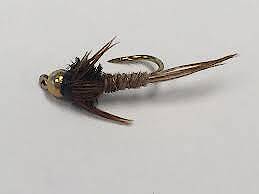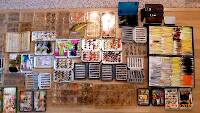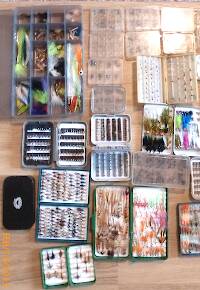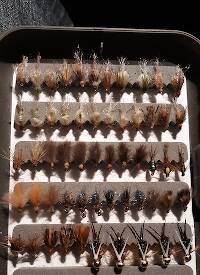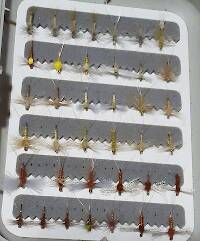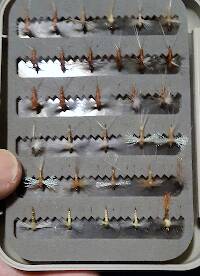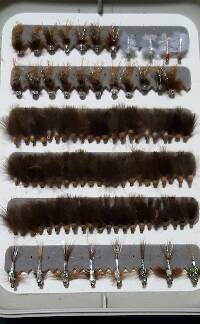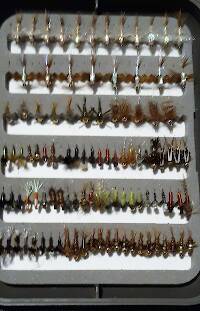
Hex Mayflies
Hexagenia limbata
The famous nocturnal Hex hatch of the Midwest (and a few other lucky locations) stirs to the surface mythically large brown trout that only touch streamers for the rest of the year.
Featured on the forum

It's only barely visible in one of my pictures, but I confirmed under the microscope that this one has a prosternal horn and the antennae are mid-way between the eyes and front of the head capsule.
I'm calling this one Pycnopsyche, but it's a bit perplexing. It seems to key definitively to at least Couplet 8 of the Key to Genera of Limnephilidae Larvae. That narrows it down to three genera, and the case seems wrong for the other two. The case looks right for Pycnopsyche, and it fits one of the key characteristics: "Abdominal sternum II without chloride epithelium and abdominal segment IX with only single seta on each side of dorsal sclerite." However, the characteristic "metanotal sa1 sclerites not fused, although often contiguous" does not seem to fit well. Those sclerites sure look fused to me, although I can make out a thin groove in the touching halves in the anterior half under the microscope. Perhaps this is a regional variation.
The only species of Pycnopsyche documented in Washington state is Pycnopsyche guttifera, and the colors and markings around the head of this specimen seem to match very well a specimen of that species from Massachusetts on Bugguide. So I am placing it in that species for now.
Whatever species this is, I photographed another specimen of seemingly the same species from the same spot a couple months later.
I'm calling this one Pycnopsyche, but it's a bit perplexing. It seems to key definitively to at least Couplet 8 of the Key to Genera of Limnephilidae Larvae. That narrows it down to three genera, and the case seems wrong for the other two. The case looks right for Pycnopsyche, and it fits one of the key characteristics: "Abdominal sternum II without chloride epithelium and abdominal segment IX with only single seta on each side of dorsal sclerite." However, the characteristic "metanotal sa1 sclerites not fused, although often contiguous" does not seem to fit well. Those sclerites sure look fused to me, although I can make out a thin groove in the touching halves in the anterior half under the microscope. Perhaps this is a regional variation.
The only species of Pycnopsyche documented in Washington state is Pycnopsyche guttifera, and the colors and markings around the head of this specimen seem to match very well a specimen of that species from Massachusetts on Bugguide. So I am placing it in that species for now.
Whatever species this is, I photographed another specimen of seemingly the same species from the same spot a couple months later.

Troutnut is a project started in 2003 by salmonid ecologist Jason "Troutnut" Neuswanger to help anglers and
fly tyers unabashedly embrace the entomological side of the sport. Learn more about Troutnut or
support the project for an enhanced experience here.
WGGIII on Jun 20, 2020June 20th, 2020, 3:31 pm EDT
Too many years of trips to and living in great fly fishing areas has left me with a collection of flys and boxes that are FILLED with one's and two’s of every pattern you can think of. Add to that 2 years worth of subscriptions to PostFly Box....and it looks like I need a 12 Step Program for buying flies.
Does anyone know of a service where I can send my flies and boxes for some sense of organization. I am not good at identifying individual flies...I’m much better at just buying them.
Any insight would be welcome.
Does anyone know of a service where I can send my flies and boxes for some sense of organization. I am not good at identifying individual flies...I’m much better at just buying them.
Any insight would be welcome.
Hunter1 on Jun 20, 2020June 20th, 2020, 11:47 pm EDT
Hi, I think fly box organization is the hardest thing to keep and do. At least for me. I fished with a guide years ago, he told me he just brings enough flys and only the ones for that particular stream and the hatches then. I replace whats lost, worn out, on a regular basis. Once a year I go an try to organize the whole box. Good post , lets see what the other guys come up with. Oh, Welcome to the forum from Maryland.
RleeP on Jun 21, 2020June 21st, 2020, 5:50 am EDT
Well, it certainly is an affliction and a hazard widespread in our sport. A lot of folks claim to have mastered it and brought it under control. Of course, a lot of folks in 12 Step groups also make the same claim for their specific problem habits.
All should be taken with a grain of salt..:)
Here is what I do and it seems to work OK. But again, remember that we are all liars to some degree..:)
If you have flies scattered hither and yon in an endless array of boxes, there is a significant upfront amount of preparation. But once this is done, it gets easier.
I have a half dozen 11X17 plastic boxes with about 20 compartments each. I have very fly I own sorted by pattern or type into these boxes. This is the part that takes a while. Then, I have a half dozen or so smaller working boxes of various sizes. When I want to go fish, I take what I need (and only what I need) from the big boxes and put them in a few of the small ones. This way, I have some idea of what is where and know where to look when I need more or less. Pretty manageable, or as manageable as this stuff ever gets anyway.
The key though is, once you are done fishing and come back home, have the discipline to refile the flies from the small boxes into the big one. Otherwise, you'll simply end up with the same problem you were trying to solve. You'll have 75 little boxes scattered all over the place and you won't really know what is in them all.
FWIW..
All should be taken with a grain of salt..:)
Here is what I do and it seems to work OK. But again, remember that we are all liars to some degree..:)
If you have flies scattered hither and yon in an endless array of boxes, there is a significant upfront amount of preparation. But once this is done, it gets easier.
I have a half dozen 11X17 plastic boxes with about 20 compartments each. I have very fly I own sorted by pattern or type into these boxes. This is the part that takes a while. Then, I have a half dozen or so smaller working boxes of various sizes. When I want to go fish, I take what I need (and only what I need) from the big boxes and put them in a few of the small ones. This way, I have some idea of what is where and know where to look when I need more or less. Pretty manageable, or as manageable as this stuff ever gets anyway.
The key though is, once you are done fishing and come back home, have the discipline to refile the flies from the small boxes into the big one. Otherwise, you'll simply end up with the same problem you were trying to solve. You'll have 75 little boxes scattered all over the place and you won't really know what is in them all.
FWIW..
Martinlf on Jun 22, 2020June 22nd, 2020, 2:02 am EDT
A lot of folks claim to have mastered it and brought it under control. Of course, a lot of folks in 12 Step groups also make the same claim for their specific problem habits.
All should be taken with a grain of salt..:)
I love Lee's replies. Always worth reading and sometimes very funny. The one above qualifies as both.
Here's what I do. Years ago I made three fly boxes from the pill boxes as described in the book Midge Magic. Each box has 7 replaceable rows of 4 small compartments with individual lids, each marked with the fly and size. I made covers for the tops of the boxes out of the plastic packaging, creating a hinge, and painting everything brown on the outside. The covers keep me from accidentally popping one of the compartments open and dumping flies accidentally. I then cut one box in half creating two small boxes, one with 4 rows the other with 3. In any one of these boxes I can pop out any one row of four compartments and replace it with another, depending on what I think I'll need. Walt's worms and green weenies rarely, if ever, leave their box though. I have about six extra pill boxes that hold flies not in use, all stored in the original clear plastic packaging to keep them easy to view and safe from dumping. Flies that can be stacked in without damage, such as nymphs, caddis, most terrestrials, and small dries such as olives go in these boxes and each box is tuned for the stream and time of year so I have what I may need in them by replacing individual rows from the storage boxes. Then I have larger hatch boxes, either commercial C&F waterproof boxes, or medium boxes with bristle tack. I have one large C&F box with early flies, mostly hendricksons, but also blue quills, olives, apple caddis, tan caddis, and one or two craneflies. Another C&F box contains sulphurs and cornutas mostly, with a few caddis, crane flies, etc just in case; another with slate drakes and cornutas and a few assorted just in case flies, such as October caddis for autumn. I have a large bristle tack box with green drakes and coffin flies; a smaller bristle tack box with March browns, etc. etc. The hatch boxes typically have all forms for mayflies, nymphs, wet flies, duns, and spinners, as needed, and adults and iris caddis emergers for caddisflies. I also almost always carry some caddis in the convertible boxes in mixed colors and sizes, both adults (mostly cdc) and iris caddis.
I like Lee's system, but am possibly too lazy to keep it all straight. I do switch out the rows in my convertible boxes, but I'm afraid with Lee's system I'd fail to replace the flies from the smaller boxes into the larger ones, and, as he says, promptly have a mess on my hands. But, as with vests, packs, etc. we all tend to find what will work in our own way. So far so good for me with this . . . but I'm always thinking there has to be a more efficient, easier way. Maybe . . . maybe not--for me.
"He spread them a yard and a half. 'And every one that got away is this big.'"
--Fred Chappell
--Fred Chappell
Martinlf on Jun 22, 2020June 22nd, 2020, 2:47 am EDT
One other thought. Knowing what one expects to find on a stream at any specific time of year is essential to fly selection, and something that generally comes with time. I remember seeing Teloganopsis deficiens for the first time, and having to tie and add that to my selection for early June on a specific river. I've never fished it anywhere else. And there were those larger black quills one day--they had to be added as well. Fly shops can often help with this--but not always. Very few know about or fish the little black quill on that river, and the fishing with them is really good only on drizzly days. So it can get complicated.
"He spread them a yard and a half. 'And every one that got away is this big.'"
--Fred Chappell
--Fred Chappell
Partsman on Jun 22, 2020June 22nd, 2020, 9:23 am EDT
Im hopeless, I currently am caring five boxes, just in case. You never know when you only be able to nymph, or streamer fish. Although the big hatch is going on now. I gave up and just carry everything I think could be useful right now. Once fall arrives it gets a little easier for me, but right now Im just crazy. I have removed a box with Hendricksons, sulpurs and bwo's. But I confess I love to tie flies and every time I see a pattern I just have try, well Im tying it and carrying with me. I think that is part of flyfishing I like the most anyways!
Mike.
Mike.
Quick Reply
Related Discussions
Topic
Replies
Last Reply
2
Nov 4, 2012
by Aszat
by Aszat
3
Mar 22, 2010
by Motrout
by Motrout
2
Nov 18, 2014
by JackDaTrout
by JackDaTrout


